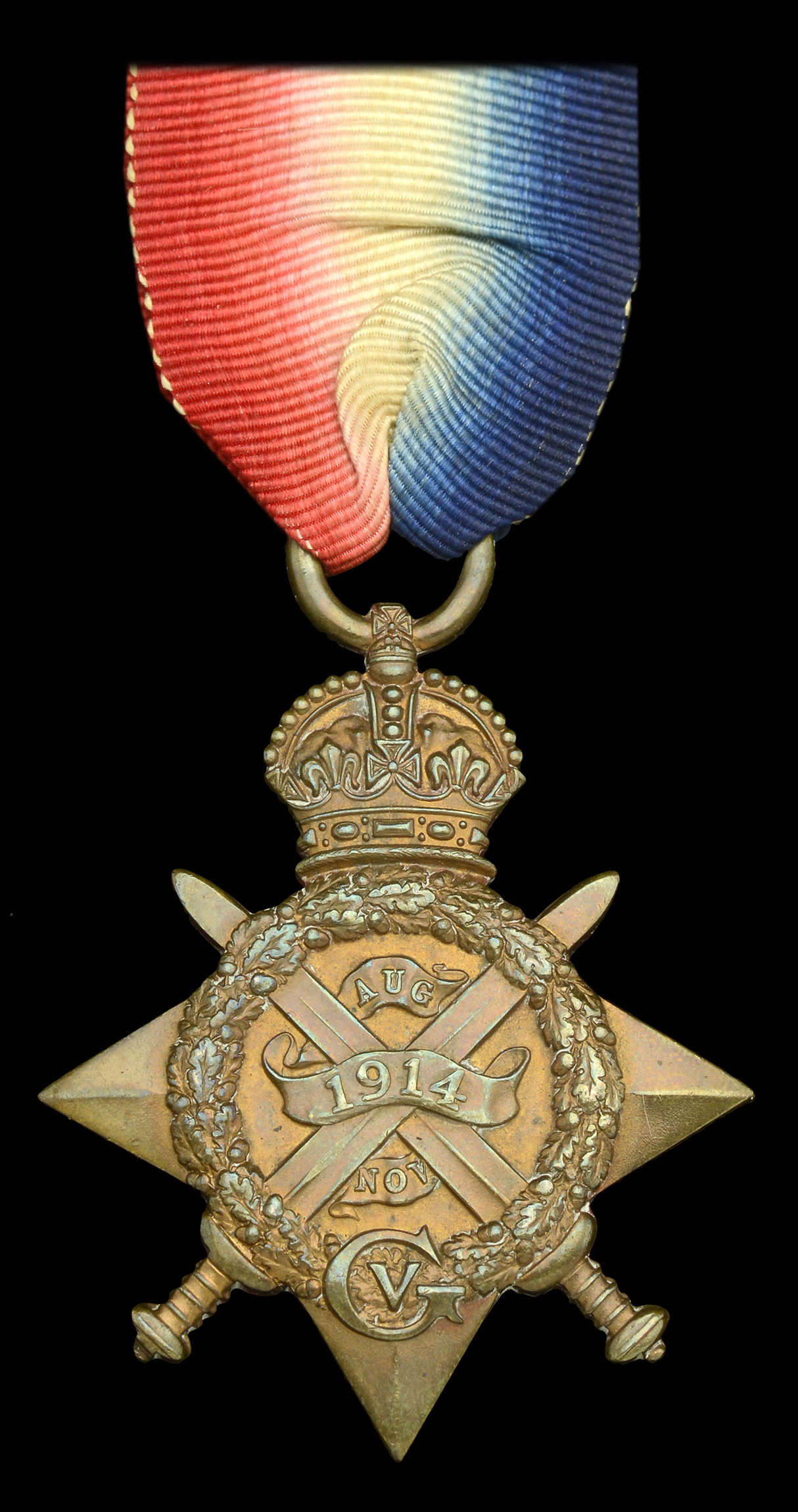352
1914 Star (6510 Pte. M. Cummins. R. Muns: Fus.) very fine £100-£140
Gebote sind ohne Steuern, Aufgeld oder Versankosten.
By confirming your bid, you agree that you have read and accepted the-saleroom.com and the auctioneer's terms and conditions. Confirming your bid is a legally binding obligation to purchase and pay for the lot should your bid be successful.
Wählen Sie eine der folgenden Schnellgebotsoptionen:
Gebote sind ohne Steuern, Aufgeld oder Versankosten.
By confirming your bid, you agree that you have read and accepted the-saleroom.com and the auctioneer's terms and conditions. Confirming your bid is a legally binding obligation to purchase and pay for the lot should your bid be successful.
---
Michael Cummins attested for the Royal Munster Fusiliers and served with the 2nd Battalion during the Great War on the Western Front from 13 August 1914, moving forward to Mons where the battalion was held in reserve for the fighting on 24 August.
Prisoner of War at Etreux
During the retreat, the 2nd Munsters occupied the position of honour as rearguard to the 1st Guards Brigade which, in turn, acted as rearguard for the 1st Division commanded by Major General Lomax. On the morning of Thursday 27 August 1914, the Irishmen, supported by two 18-pounders of the 118th Battery R.F.A. and a troop of the 15th Hussars, held the villages of Fesmy and Bergues, together with two important road junctions in that immediate area. Approaching them in an arc from North to East was an entire German Army Corps preceded by masses of cavalry and backed by an impressive array of artillery. Early in the afternoon, having inflicted savage casualties on 12 battalions of the German 2nd Guards’ Reserve Division which had attacked Fesmy, the Munsters began to withdraw to the South to the village of Oisy, and on to Etreux. At 5.30pm the battalion was located at a crossroads just east of Oisy. Jordan’s “B” Company, however, was missing and the retreat was held up. The company reappeared at about 6.30pm but the delay, according to Captain McCance’s regimental history, proved ‘fatal to the battalion’.
Approaching the village of Oisy, the battalion came under heavy fire from the houses on the northern outskirts, followed by salvoes from eight German field guns positioned south-east of the village. Now, for the first time, the Irishmen began to fall thick and fast and although the one remaining 18-pounder promptly came into action, its ammunition was nearly exhausted. After a series of desperate bayonet attacks, and with the artillerymen all dead and wounded about their gun, the gallant Munsters fell back to an orchard on the west of the road. Despite a further bayonet charge, at odds of fifty to one, which had temporarily held the enemy, the orchard was now ringed by Germans against whom the survivors, lining the four sides of the orchard, made every shot count.
Ultimately, due to appalling casualties, lack of ammunition and the overwhelming superiority of enemy numbers, the survivors of the Battalion were compelled to surrender around 9pm. They had been fighting for 12 hours and their senior surviving officer was a Lieutenant but their sacrifice had ensured that Haig’s 1 Corps could continue unharassed on its way.
Cummins was amongst those taken Prisoner of War at Etreux on 27 August 1914. Repatriated following the cessation of hostilities, he was discharged Class Z on 27 March 1919.
Sold with copied research.
---
Michael Cummins attested for the Royal Munster Fusiliers and served with the 2nd Battalion during the Great War on the Western Front from 13 August 1914, moving forward to Mons where the battalion was held in reserve for the fighting on 24 August.
Prisoner of War at Etreux
During the retreat, the 2nd Munsters occupied the position of honour as rearguard to the 1st Guards Brigade which, in turn, acted as rearguard for the 1st Division commanded by Major General Lomax. On the morning of Thursday 27 August 1914, the Irishmen, supported by two 18-pounders of the 118th Battery R.F.A. and a troop of the 15th Hussars, held the villages of Fesmy and Bergues, together with two important road junctions in that immediate area. Approaching them in an arc from North to East was an entire German Army Corps preceded by masses of cavalry and backed by an impressive array of artillery. Early in the afternoon, having inflicted savage casualties on 12 battalions of the German 2nd Guards’ Reserve Division which had attacked Fesmy, the Munsters began to withdraw to the South to the village of Oisy, and on to Etreux. At 5.30pm the battalion was located at a crossroads just east of Oisy. Jordan’s “B” Company, however, was missing and the retreat was held up. The company reappeared at about 6.30pm but the delay, according to Captain McCance’s regimental history, proved ‘fatal to the battalion’.
Approaching the village of Oisy, the battalion came under heavy fire from the houses on the northern outskirts, followed by salvoes from eight German field guns positioned south-east of the village. Now, for the first time, the Irishmen began to fall thick and fast and although the one remaining 18-pounder promptly came into action, its ammunition was nearly exhausted. After a series of desperate bayonet attacks, and with the artillerymen all dead and wounded about their gun, the gallant Munsters fell back to an orchard on the west of the road. Despite a further bayonet charge, at odds of fifty to one, which had temporarily held the enemy, the orchard was now ringed by Germans against whom the survivors, lining the four sides of the orchard, made every shot count.
Ultimately, due to appalling casualties, lack of ammunition and the overwhelming superiority of enemy numbers, the survivors of the Battalion were compelled to surrender around 9pm. They had been fighting for 12 hours and their senior surviving officer was a Lieutenant but their sacrifice had ensured that Haig’s 1 Corps could continue unharassed on its way.
Cummins was amongst those taken Prisoner of War at Etreux on 27 August 1914. Repatriated following the cessation of hostilities, he was discharged Class Z on 27 March 1919.
Sold with copied research.
Orders, Decorations, Medals and Militaria
Auktionsdatum
Ort der Versteigerung
Generelle Versandinformationen vom Auktionshaus verfügbar
If you are successful in purchasing lot/s being auctioned by us and opt for the item/s to be sent to you, we will use the following methods of shipment:
Within the UK
If you live within the UK, items will be despatched using Royal Mail Special Delivery. This service provides parcel tracking (via the Royal Mail website) and next weekday delivery (betwen 9am and 1pm). Items delivered within the UK are covered by our insurance company. Heavy and bulky lots will be sent by courier, in discussion with the client.
Outside of the UK
If the item/s being sent are worth under £1000 in total they are sent using Royal Mail’s Signed For International service. This ensures the item must be signed for when it is delivered.
If the item/s being sent are valued at over £1000 in total they will be sent using FedEx. This service allows next day delivery to customers in many parts of the US and parcels are fully trackable using the FedEx website.
Shipping Exceptions
Certain lots such as those containing glass or sharp implements, etc., may not be suitable for in-house shipping within or outside of the UK. Please contact Noonans with any queries.
Wichtige Informationen
Auctioneer's Buyers Premium: 24% (+VAT)
There is an additional charge of 4.95% (+VAT/sales tax)










